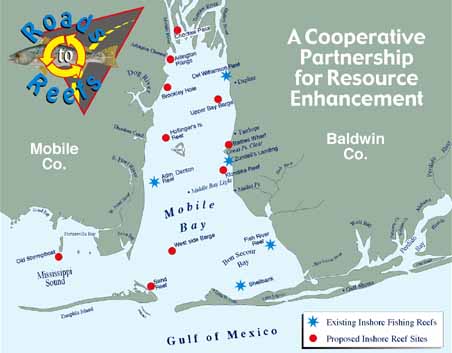Roads to Reefs

The Roads to Reefs program is a Marine Habitat Enhancement Project that will provide habitat improvements benefiting mollusks, crustaceans, forage fish, and predatory fish including oysters and many inshore fish species such as spotted sea trout, white trout, and flounder.
Recycled concrete from road construction projects is used to construct artificial reefs in the Mobile Bay estuary.
The first of ten reefs constructed in the Roads to Reefs project was completed at Choctaw Pass near the mouth of the Mobile River in February of 2000. Choctaw Pass Reef is a dedicated fishing reef, built on a hard bottom characterized by scattered shell hash and relict pilings. The reef was built using concrete block surrounded by a perimeter of concrete pipe, and all materials and labor were donated by local fishermen and business professionals. Only clean pipe, free of oil or asphalt residue that could damage the Bay’s ecosystem, will be recycled and used in the Roads to Reefs project.
Nine sites in Mobile Bay and one in the Alabama portion of Mississippi Sound were selected and permitted by USACOE for enhancement. Three of these were cases of relict oyster reef rehabilitation, each to encompass several acres of newly applied oyster cultch material within a perimeter of concrete pipe and rubble. The remaining seven were smaller, all-concrete reefs to be built on relict snags and sunken vessels, and to be dedicated to recreational angling.
"The natural bottom in Mobile Bay and off the Alabama coast is predominately flat sand and mud, which attracts few fish that are valuable for recreation or commercial purposes," explained Jim Duffy of the Marine Resources Division. "Anything that adds vertical relief quickly transforms the character of the habitat. Artificial reefs attract encrusting organisms like coral and sponge and once they are established, small bait fish take up residence and larger fish are attracted. After the complete reef food web is created, the artificial reef functions as a natural reef."
Partners
Alabama Wildlife Federation; Alabama Department of Conservation and Natural Resources, Marine Resources Division; Mobile County Wildlife and Conservation Association; Coastal Conservation Association – Alabama; Mobile County Commission; Woolpert LLP
 Wildlife Tag
Wildlife Tag